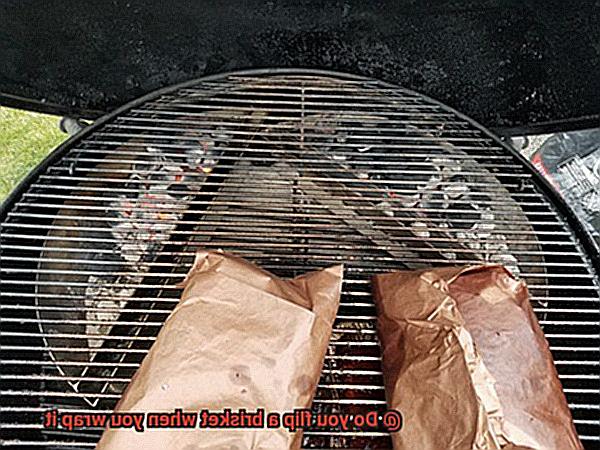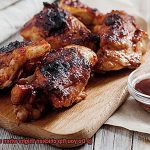Hey there, fellow grill masters. Have you ever found yourself in a sticky situation when it comes to flipping a wrapped brisket? I know I have. The debate rages on – should you flip or not flip? It’s the question that has caused many a sleepless night for backyard pitmasters and kitchen cooks alike.
To flip or not to flip? Let’s take a closer look at both sides of this age-old debate. Some swear by leaving the brisket untouched, claiming that flipping can cause moisture loss and ruin that perfect bark we all crave. Others argue that flipping is essential, as it helps distribute heat evenly and prevents dryness.
But what does science say about this issue? To get to the bottom of things, we need to understand how heat affects meat and the properties of brisket itself. Whether you’re an experienced pro or just starting out, knowing whether or not to flip your brisket is key to achieving that heavenly taste we all crave. So grab your tongs and put on your apron because it’s time to settle this once and for all – do you flip a brisket when you wrap it?
Contents
What is a Brisket?
Brisket is more than just a cut of meat. It’s a culinary experience that requires patience, skill, and a love for tender, flavorful meat. At its core, a brisket is the breast or lower chest of a cow – a tough muscle that’s packed with rich flavor. But to truly understand this beloved meat, you must first know its anatomy.
A brisket consists of two distinct muscles: the flat and the point. The flat is leaner and easier to overcook, while the point has more fat and flavor. When cooking a brisket, it’s crucial to take these differences into account and adjust your technique accordingly.
Whether you’re smoking, grilling, or slow-cooking your brisket, the goal is always the same: melt-in-your-mouth tenderness. That’s why brisket is a popular choice for barbecue and smoked meat dishes, as well as traditional Jewish cuisine. With the right cooking method and plenty of time, you can transform this tough cut of meat into a juicy, flavorful masterpiece.
Now, let’s tackle the big question: should you flip your brisket when you wrap it? The answer isn’t straightforward – it depends on your cooking situation and personal preference. In most cases, flipping isn’t necessary. When you wrap your brisket, you create a sealed environment that allows the meat to cook in its own juices. Flipping it could disrupt this process and lead to uneven cooking or moisture loss.
However, there are situations where flipping might be beneficial. For example, if you’re cooking on a grill with uneven heat distribution, flipping can help ensure even cooking on both sides. Additionally, flipping halfway through the cooking process can result in an evenly developed bark – that crispy crust that forms on the outside of the meat.

Regardless of whether you choose to flip your brisket or not, one thing is certain: proper technique is key to achieving that melt-in-your-mouth tenderness. That means using the right cooking method for your chosen cut, adjusting your technique based on the flat and point muscles, and paying close attention to temperature and timing.
Should You Flip a Brisket When You Wrap It?
You might be wondering whether or not you should flip your brisket when you wrap it. As an expert on all things brisket, I’m here to break down the pros and cons of flipping during the wrapping process.
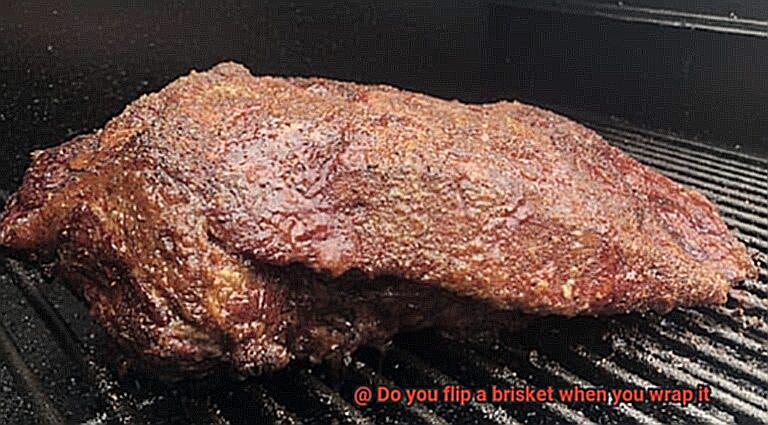
To begin with, there are different methods for wrapping a brisket. Some prefer the Texas crutch method, which involves wrapping the brisket in aluminum foil or butcher paper during the cooking process. However, debate often arises about whether or not to flip the meat when wrapping it.
Those who advocate for flipping argue that it can ensure even cooking and prevent the meat from becoming too dry on one side. Flipping also allows for better circulation of juices and marinades throughout the meat. Plus, if you’re dealing with uneven heat distribution in your smoker, flipping can help even things out.
On the other hand, those who do not flip argue that it can disrupt the bark on the brisket. The bark is a flavorful crust that develops on the outside during cooking and flipping can cause it to become uneven or even fall off. Additionally, flipping can cause the meat to become unevenly cooked and may result in a loss of moisture.
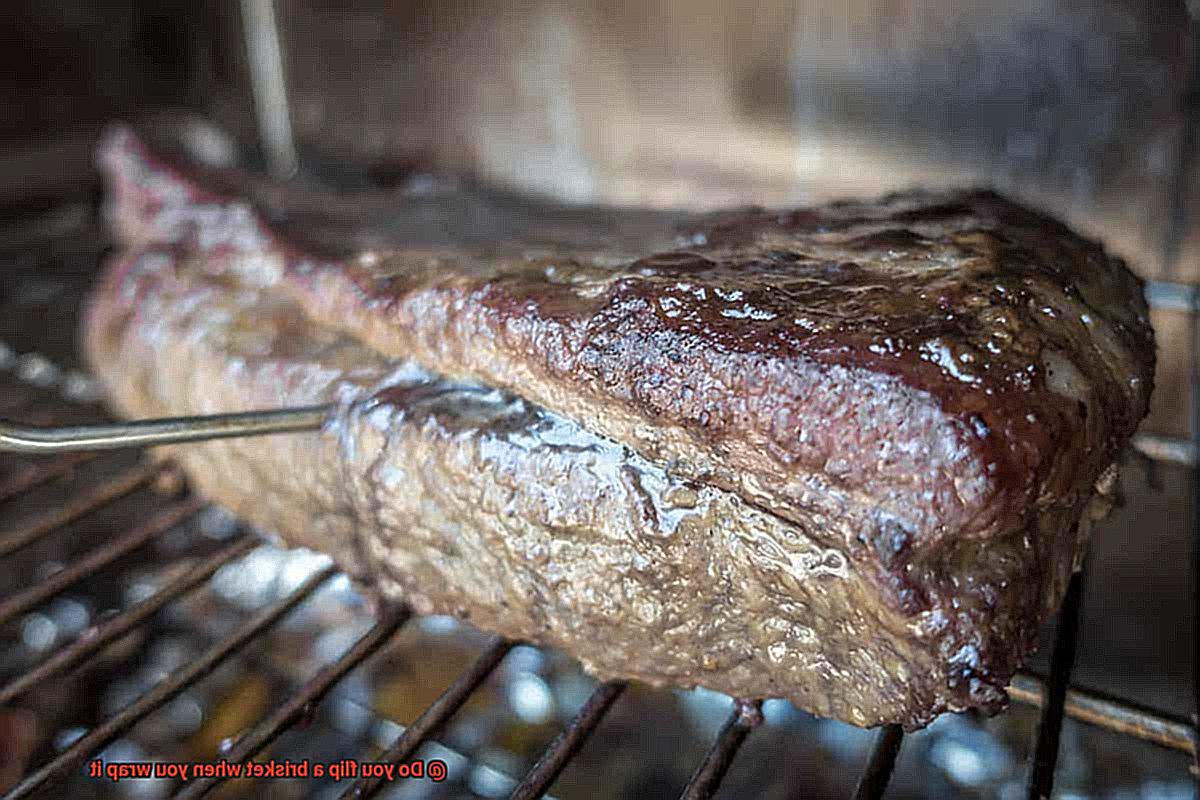
So, what’s the verdict? Whether or not you should flip your brisket when you wrap it depends on personal preference and the specific method you are using. Some pitmasters swear by flipping, while others never flip their briskets. It is important to experiment and find what works best for you and your cooking style.
If you do decide to flip your brisket, be sure to do so carefully and quickly to minimize any disruption to the bark. Additionally, remember that flipping may cause uneven cooking, so consider rotating your brisket instead of flipping it.
Regardless of whether you choose to flip or not, always remember to wrap your brisket tightly to ensure that moisture is retained and flavors are infused into the meat. And, if you’re still unsure about whether to flip or not, try experimenting with both methods to find what works best for you.
Reasons to Not Flip a Brisket When Wrapping It
While some pitmasters swear by flipping, others argue that it’s unnecessary and may even harm the final result. In this article, we’ll explore why some experts recommend not flipping a brisket when wrapping it.
Firstly, flipping can cause the bark to become soggy. The bark is the delicious, crispy exterior of the brisket that forms during smoking and is full of flavor. By flipping the brisket after wrapping it, the bark comes into contact with the moist environment inside the wrapping. This can cause it to lose its texture and flavor, resulting in a less appetizing end product.
Secondly, flipping can disrupt the cooking process. Brisket is notoriously difficult to cook and requires low and slow cooking to become tender. Flipping the brisket can cause uneven cooking and result in dry or tough areas in the meat. Small changes in temperature or cooking time can greatly impact the final result, so it’s important to be cautious when making any adjustments.
Lastly, some experts believe that flipping is simply unnecessary. If you wrap your brisket tightly enough, it will retain moisture and cook evenly without needing to be flipped. This approach allows you to keep the bark intact and ensures that the brisket cooks evenly from all sides. By avoiding unnecessary handling of the meat, you also reduce the risk of contamination or damage to the brisket.
Situations Where Flipping a Brisket May be Necessary
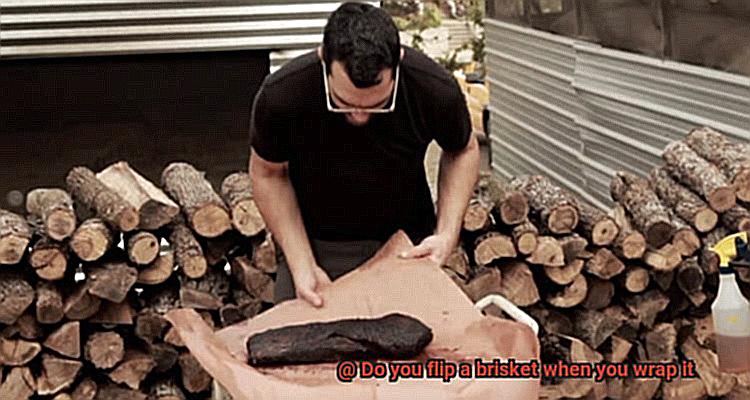
Some believe it’s unnecessary and can even ruin the meat, while others swear by it. However, there are certain situations where flipping a brisket may be necessary to achieve the perfect cook.
Firstly, uneven cooking can be a common issue when smoking a brisket. If one side is facing the heat source and receiving more heat than the other side, flipping the brisket can help even out the cooking process. This ensures both sides of the meat are cooked to perfection, resulting in a delicious and evenly cooked brisket.
Secondly, time constraints can also be a factor in deciding whether to flip your brisket. If you’re running out of time and need to speed up the cooking process, flipping the brisket can help cook it faster. By exposing the other side of the meat to direct heat, you can shave off some cooking time and still achieve that perfect smoky flavor.
Finally, flipping a brisket can also help prevent it from drying out. When you flip the meat, you distribute the juices more evenly across both sides of the brisket, keeping it moist and juicy throughout the cooking process.
However, it’s important to note that flipping too frequently can have negative consequences on both texture and flavor. Over-flipping can lead to dry and tough meat or cause loss of bark, which is that delicious crispy outer layer that forms during cooking.
Creating an Even Bark Through Flipping
Flipping a brisket when wrapping it is a technique that can help achieve an even bark, ensuring every bite is packed with flavor.
Timing is key in achieving an even bark through flipping. Once your brisket has reached an internal temperature of around 160-170°F, it’s time to carefully flip the meat over. This technique allows the other side to receive the same smoky treatment as the first side, ensuring each side of the brisket is evenly coated with smoke and seasoning.
When flipping your brisket, handle it gently to avoid tearing or damaging the bark. Use sturdy tongs or meat claws to lift and turn the meat over before re-wrapping it tightly in foil or butcher paper and returning it to your smoker or grill.
Some pitmasters suggest flipping every hour or so during the cooking process for even browning on all sides. However, others argue that too much flipping can disrupt the cooking process and result in a less flavorful end product. The perfect technique for your equipment and cooking style may take some trial and error, but with practice, you can achieve a beautifully bark-covered brisket every time.
Tips for Carefully Flipping a Wrapped Brisket
Smoking a brisket to perfection requires patience, skill, and attention to detail. One aspect that often confuses barbecue enthusiasts is whether or not to flip the brisket when it’s wrapped. While opinions vary, many experts recommend flipping your brisket to ensure even cooking and prevent any one side from getting too dry or overcooked. However, flipping a large, unwieldy piece of meat like a brisket can be easier said than done. Here are some tips for carefully flipping a wrapped brisket:
Use Sturdy Tools
To flip your brisket with confidence, make sure you have sturdy tongs or a flat spatula with a wide surface area that can handle the weight of the meat without bending or breaking. You don’t want to risk dropping it or tearing the foil.
Get Some Extra Help
If you’re feeling nervous about flipping your brisket on your own, don’t hesitate to recruit a friend or family member to help you out. Two sets of hands can make the process much smoother and less stressful.
Work Quickly But Carefully
When you’re ready to flip your brisket, work quickly but carefully to avoid jostling it too much. Gently lift the brisket with your tools and carefully flip it over onto another sheet of foil. The longer the brisket is off the grill or smoker, the more it will cool down, so try to move quickly.
Be Mindful of the Juices
As you flip your brisket, be mindful of any juices that may have accumulated in the foil. You don’t want to spill these or let them get lost—try to keep them contained as much as possible. These juices are essential for keeping the meat moist and flavorful.
Wrap It Back Up Tightly
Once you’ve flipped your brisket, wrap it back up tightly in the foil and continue cooking as usual. Make sure the foil is snug and sealed, so the meat stays moist and tender.
Conclusion
As the age-old debate rages on, it’s clear that there is no one-size-fits-all answer to the question of whether to flip a brisket when wrapping. Some pitmasters swear by flipping, claiming it leads to even cooking and a perfectly developed bark. Others argue that flipping can disrupt the bark and lead to uneven cooking.
Ultimately, your decision to flip or not should be based on personal preference and your chosen cooking method. If you do decide to flip your brisket, proceed with caution. Quick and careful flips will minimize any damage to the bark. Additionally, consider rotating your brisket instead of flipping it to avoid uneven cooking.
Timing is also crucial when it comes to flipping. Wait until the internal temperature reaches around 160-170°F before carefully turning your meat over for an even bark.
But whether you choose to flip or not, proper technique is essential in achieving tender, melt-in-your-mouth brisket. This means using the right cooking method for your chosen cut, adjusting your technique based on the flat and point muscles, and paying close attention to temperature and timing.
In summary, creating a mouth-watering brisket takes patience, skill, and attention to detail – regardless of whether or not you choose to flip it when wrapping.

